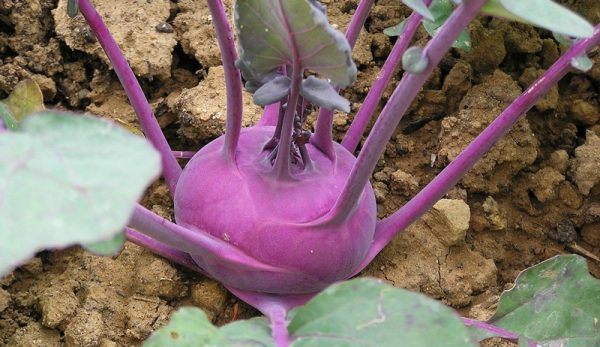
If ever there were a more ridiculous-looking vegetable, I don’t know about it. But tasty, versatile and hardy, kohlrabi’s alien looks are redeemed by its other qualities.
Kohlrabi is in the brassica family, as cool-weather crops tend to be. It forms a bulb just above the ground—looks like a root vegetable growing above the soil—and has meaty stems growing from the bulb, ending in leaves that resemble small collards.
All of the above-ground parts are edible. The bulb—actually an enlarged stem—tastes like a cross between a cabbage and an apple, with a crisp, refreshing texture. The leaves taste a little like cabbage, a little like broccoli.
The word kohlrabi is German, meaning cabbage turnip. I see where they get that.
How to Grow Kohlrabi
You’ll find green varieties and purple varieties. I like to plant a few of each color, just because they’re beautiful together!
Start seeds early in the spring for late-spring/early summer harvest or late in the summer for fall/early winter harvest. Kohlrabi stores well with refrigeration, so don’t be afraid to plant extra for fall harvest.
Bulb development requires consistent moisture and cool temps.
In the spring, plant directly into the garden if you’re getting a late start, or seed into trays indoors and transplant when nighttime temps are above freezing. With a row cover, even small plants can handle a light frost.
In the summer, try giving your plant starts shade, whether that be by planting in the shade of something tall and full or with shade cloth.
Plant or thin to 5 inches in rows 1 foot apart. If thinning, those tiny kohlrabi plants make tender, succulent salad toppings.
Cover kohlrabi with row cover if flea beetles are a problem. They don’t have flowering parts that need pollination, so you can keep them covered if the weather isn’t hot.
Read more: Kohlrabi can be a difficult market veggie, but these tips will help you make the sale.
How to Harvest
Kohlrabi generally sizes up in two months or less. Left to grow too long, bulbs can become woody, particularly as warm weather sets in.
If you’re growing for a market, harvest when the bulb is a bit larger than a golf ball, and bunch two or three together. Mix up green and purple in your bunches for an eye-catching presentation!
Golf ball- to tennis ball-sized kohlrabi bulbs are a good harvest size. You might be able to get away with some the size of an orange or grapefruit in moist and cool seasons, but that’s pushing the boundaries of getting woody.
Using shears, cut the bulb from the root at soil level. Keep your shears out of the soil, otherwise you’ll smear dirt all over the cut end of the kohlrabi, and it’s a mess.
Discard damaged leaves in the garden. If storing the kohlrabi for future use, remove all of the leaves. If distributing in the next few days, leave the top few rows of leaves attached.
How to Eat Kohlrabi
My job was once to organize events for a farmers market, including food sampling. The day we offered free samples of raw kohlrabi, the farmers sold out of kohlrabi. That was a first. You gotta try it to believe it.
Peel larger bulbs, but don’t bother peeling smaller, more tender bulbs.
Raw, sliced kohlrabi is great for dipping in hummus or dressing or for a snack as-is. Try grating it and tossing with grated ginger, grated carrot, lemon juice and salt for a slaw-like salad.
The bulb roasts nicely—think baked kohlrabi fries—and is a star in stir fries.
Also try kohlrabi boiled then mashed with salt and butter. It’s similar to mashed turnips!
Use the leaves as you would any leafy greens.
Eat kohlrabi because it’s delicious and also good for you: 1 cup of raw kohlrabi contains nearly 100 percent of the daily requirement for vitamin C, plus it’s a good source of fiber, according to Michigan State University Extension.
Let the jokesters make their remarks, but don’ t let them dissuade you from growing kohlrabi in your spring and fall gardens! The taste, versatility, storage qualities and nutrition of this cole crop are serious.




